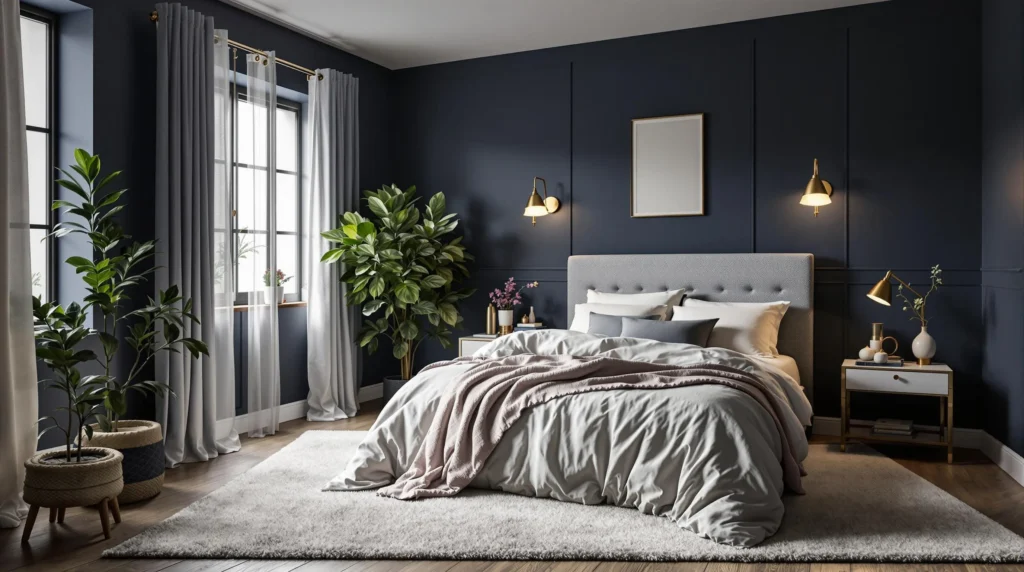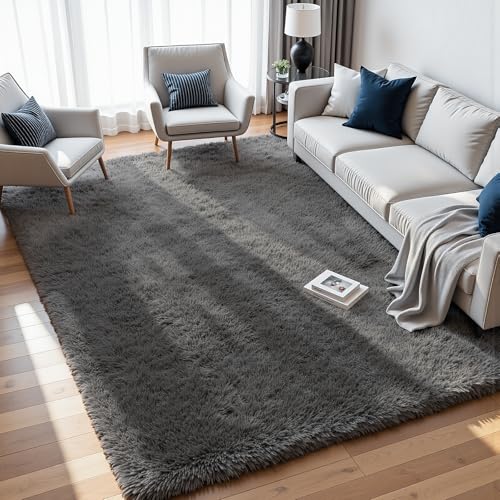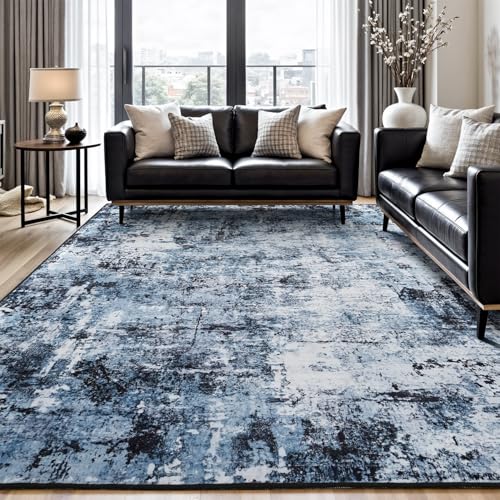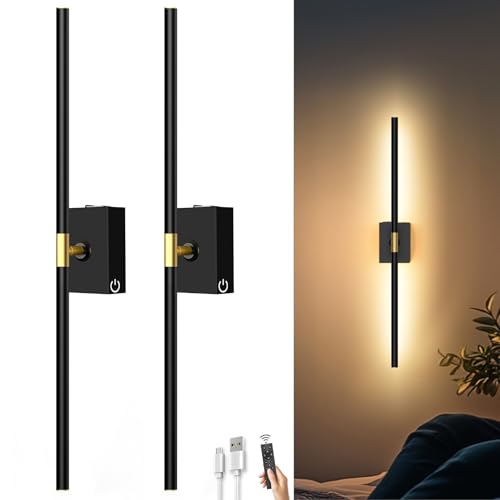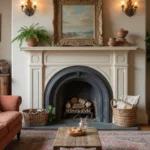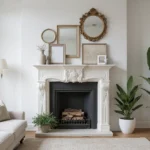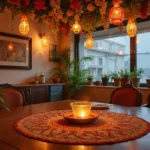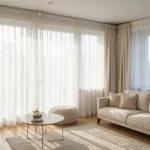Craving a bedroom that wraps you in comfort at day’s end? Moody dark colors might be exactly what you’re looking for. Unlike bright, energetic hues, deep shades create an intimate sanctuary that promotes relaxation and better sleep quality.
We’ll explore how rich navies, velvety plums, and smoky charcoals can transform your bedroom into the cozy retreat you’ve always wanted. These sophisticated tones don’t just look stunning—they create a psychological effect that signals your brain it’s time to unwind. Dark walls paired with soft textiles and ambient lighting create the perfect formula for ultimate bedroom coziness.
Why Moody Dark Colors Create the Perfect Cozy Bedroom Atmosphere
Dark colors have an innate ability to transform bedrooms into intimate sanctuaries that embrace you after a long day. Their rich depth creates visual boundaries that make large spaces feel more contained and personal. The psychological impact of dark hues like deep navy, forest green, and charcoal gray naturally signals to our brains that it’s time to relax and unwind.
When light interacts with dark-colored walls, it creates a soft, diffused glow rather than harsh reflections. This lighting effect mimics the natural dimming that occurs at sunset, helping to regulate our circadian rhythms and prepare our bodies for sleep. Most interior designers recommend dark colors specifically for bedrooms because they absorb light rather than reflect it, reducing visual stimulation that can interfere with rest.
Dark colors also provide the perfect backdrop for layering textures and creating visual interest. The contrast between moody walls and soft textiles becomes more pronounced, improving the tactile experience of your bedroom. Furniture pieces, artwork, and decorative elements stand out dramatically against darker backdrops, allowing you to create focal points that draw the eye exactly where you want it.
Temperature perception is notably influenced by color psychology, with dark tones making spaces feel physically warmer even without changing the thermostat. Research shows that rooms painted in deep, saturated colors are consistently perceived as 2-4 degrees warmer than identically heated rooms with light walls. This warming effect is particularly valuable for creating that coveted cozy atmosphere during colder months.
Sound absorption improves significantly in darker-colored spaces, as dense pigments in these paints often create a slightly more textured surface that helps dampen noise. The resulting acoustic environment feels more private and insulated from the outside industry, further improving the cocoon-like quality that makes bedrooms truly restful retreats.
Exploring Rich Navy Blues for a Classic Cozy Feel
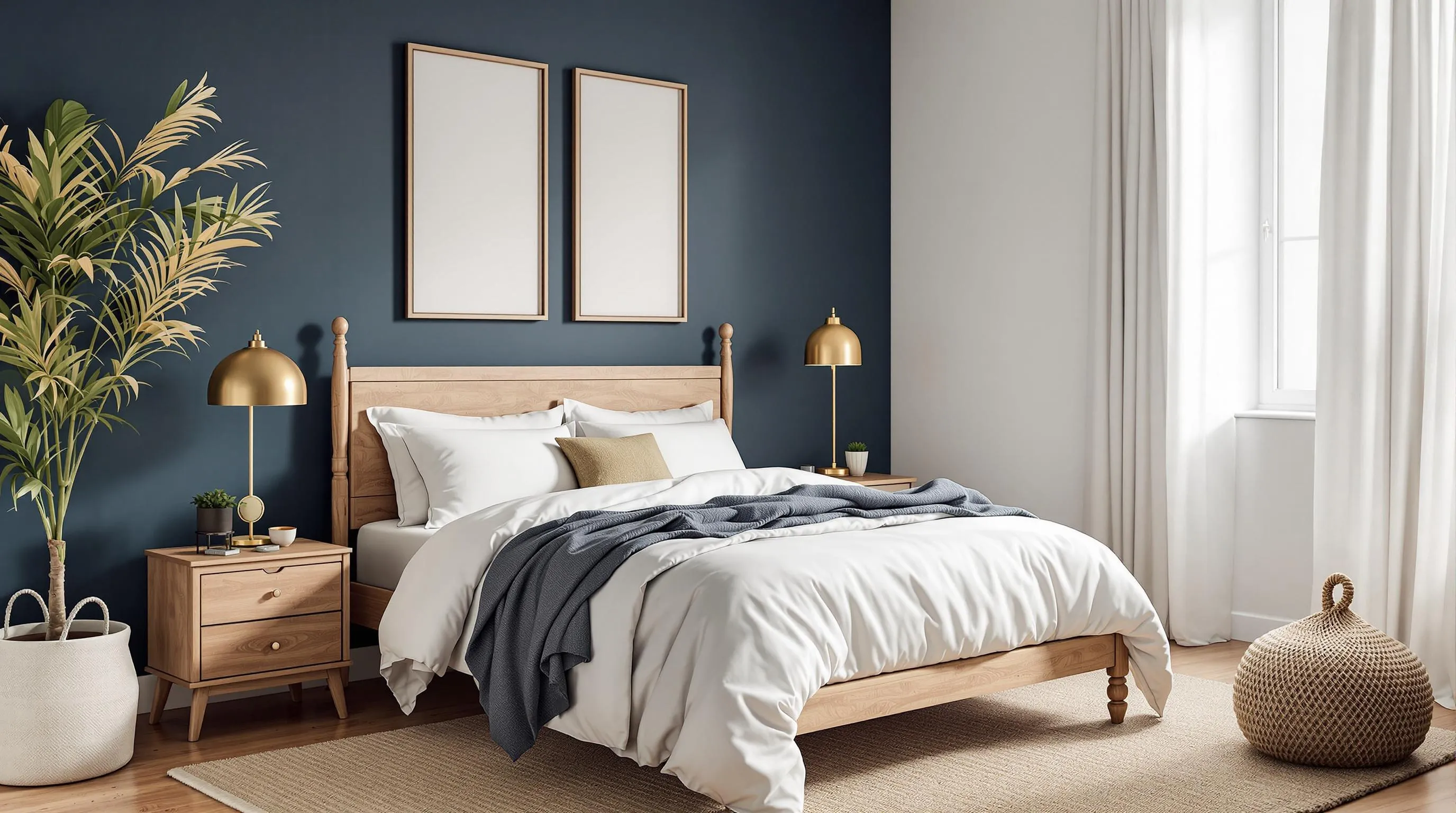
Navy blue stands out as a versatile dark hue that instantly creates a calming, intimate atmosphere in bedrooms. Its depth adds sophisticated elegance while maintaining essential warmth when properly balanced with lighter neutrals. For a truly serene retreat, we recommend pairing navy walls with crisp white linens or incorporating soft-textured rugs to offset its intensity.
Pairing Navy With Metallic Accents
Metallic accents transform navy blue bedrooms by elevating the color’s natural richness and adding both glamour and necessary contrast. Gold elements such as bedside lamps, picture frames, or decorative mirrors introduce warmth and reflectivity, working particularly well against matte navy backdrops. Silver accents complement cooler-toned navy schemes beautifully, especially in celestial-themed designs where shimmering decor creates a sophisticated night-sky effect. Bronze fixtures offer a middle ground between gold and silver, providing vintage appeal that enhances navy’s timeless quality while adding dimension to the space.
Navy Blue and Natural Wood: A Timeless Combination
Natural wood elements balance navy’s formality with organic warmth, fostering a grounded, inviting bedroom aesthetic that feels both refined and comfortable. Light wood tones like oak or walnut contrast elegantly with dark navy walls, creating visual interest without overwhelming the space. Darker woods enhance depth for more moody, cohesive interiors when a more dramatic effect is desired. This pairing works across many design styles—from clean minimalist to relaxed bohemian—especially when complemented with textured textiles like linen or jute. We find that incorporating wooden furniture pieces, exposed beams, or even subtle accents like picture frames can significantly soften navy’s boldness while maintaining its cozy, enveloping qualities.
Embracing Deep Forest Greens for Nature-Inspired Comfort

Deep forest greens create a nature-inspired element in bedrooms that instantly evokes relaxation and tranquility. This rich, moody color connects your sleeping space to the natural industry, bringing the calming essence of forests indoors while creating a cozy sanctuary.
Forest Green With Brass Elements
Pairing forest green with brass elements elevates your bedroom design to luxurious heights. Brass accents provide a sophisticated contrast against the darker green backdrop, creating visual interest and depth. Incorporating brass in lighting fixtures, drawer pulls, or decorative objects adds warmth and richness to the space. The metallic sheen of brass catches light beautifully, preventing the deep green from feeling too heavy or overwhelming. Many designers recommend this combination for its timeless appeal that works well in both traditional and contemporary bedroom styles.
Botanical Accents in Green Bedrooms
Adding botanical accents to forest green bedrooms enhances their natural and calming ambiance. Plants like ferns, potted palms, or trailing ivy reinforce the connection to nature while improving air quality for better sleep. Floral patterns on textiles such as throw pillows, duvet covers, or curtains bring visual texture and interest to the space. Botanical artwork or wall murals can serve as focal points that complement the green walls without competing with them. These natural elements create a serene environment that promotes relaxation and mindfulness, making your bedroom feel like a peaceful retreat from everyday stress.
Dramatic Charcoal Grays That Transform Sleeping Spaces
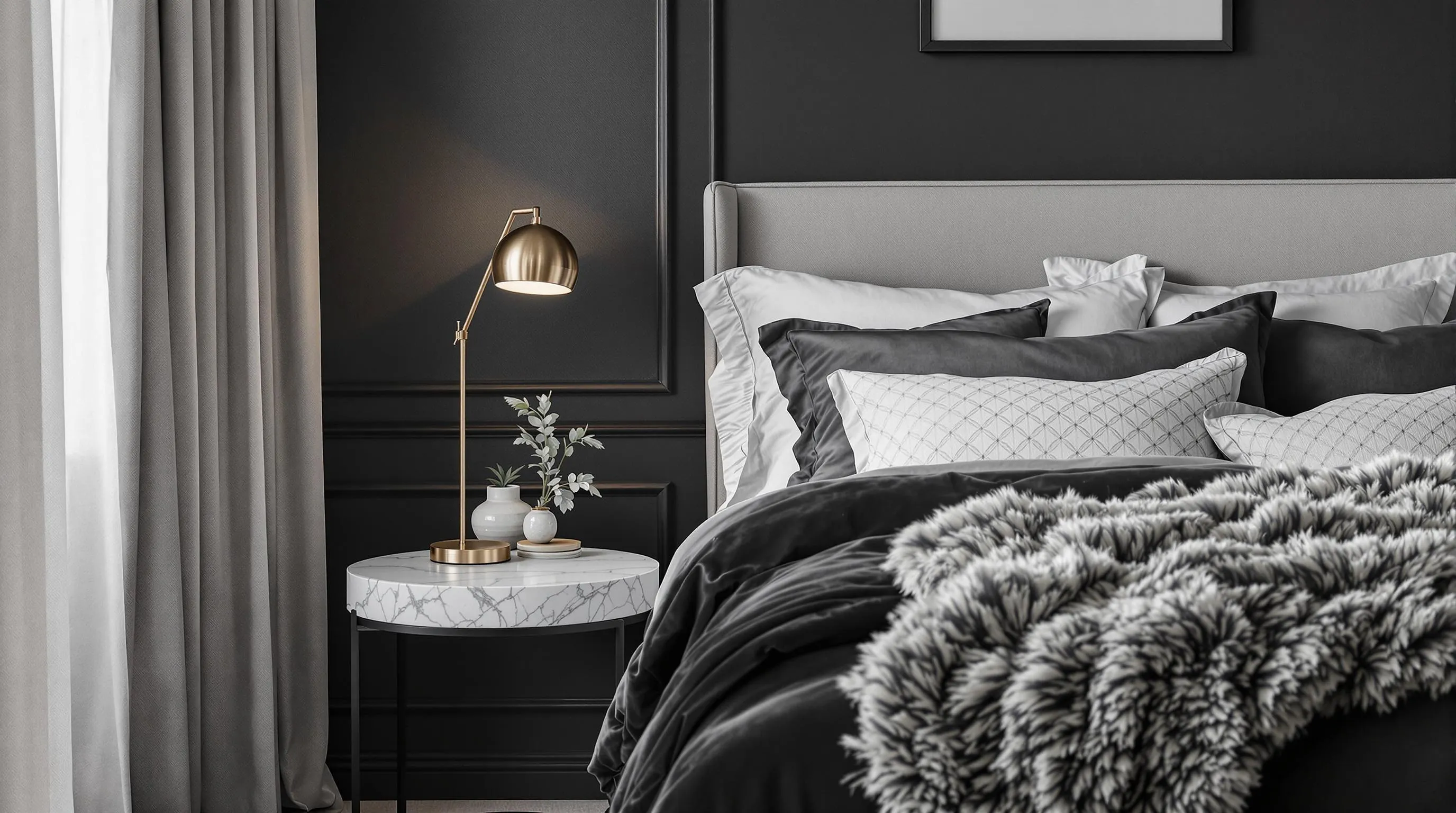
Deep charcoal grays create a modern, enveloping atmosphere in bedrooms, offering a versatile base that instantly elevates your sleeping space. These sophisticated shades add depth and drama while maintaining essential warmth through strategic design choices.
Layering Textures With Charcoal Backdrops
Charcoal walls provide the perfect canvas for creating rich textural depth in your bedroom. Velvet bedding introduces a luxurious touch against the dramatic backdrop, while faux fur throws add warmth and tactile interest. Linen curtains offer a beautiful textural contrast with their natural, slightly rumpled appearance that softens the intensity of charcoal walls. Materials with different finishes—matte and glossy—create visual complexity that draws the eye without overwhelming the space. Marble side tables paired with metallic lamps, for example, introduce subtle reflective qualities that prevent the room from feeling flat or one-dimensional. Textural variety transforms a simple charcoal bedroom into a sophisticated sanctuary where each element feels intentionally curated for comfort and style.
Charcoal and White: The Perfect Contrast
Striking balance comes naturally when pairing charcoal walls with crisp white elements. White linens create a dramatic visual break that prevents the space from feeling too heavy or enclosed. Trim painted in bright white frames charcoal walls beautifully, defining architectural features while maintaining the room’s cozy atmosphere. Dark wood furnishings complement this high-contrast palette, adding natural warmth that softens the starkness of the black-and-white combination. Upholstered pieces in charcoal tones extend the color story throughout the room while maintaining visual interest. Strategic use of glossy paint finishes reflects available light, preventing charcoal spaces from feeling cavernous or oppressive. Dimmable lighting fixtures—particularly sconces or pendant lights—ensure these high-contrast rooms remain adaptable for relaxation at any time of day, allowing you to control the mood and functionality of your charcoal sanctuary.
Luxurious Burgundy and Wine Tones for Romantic Retreats
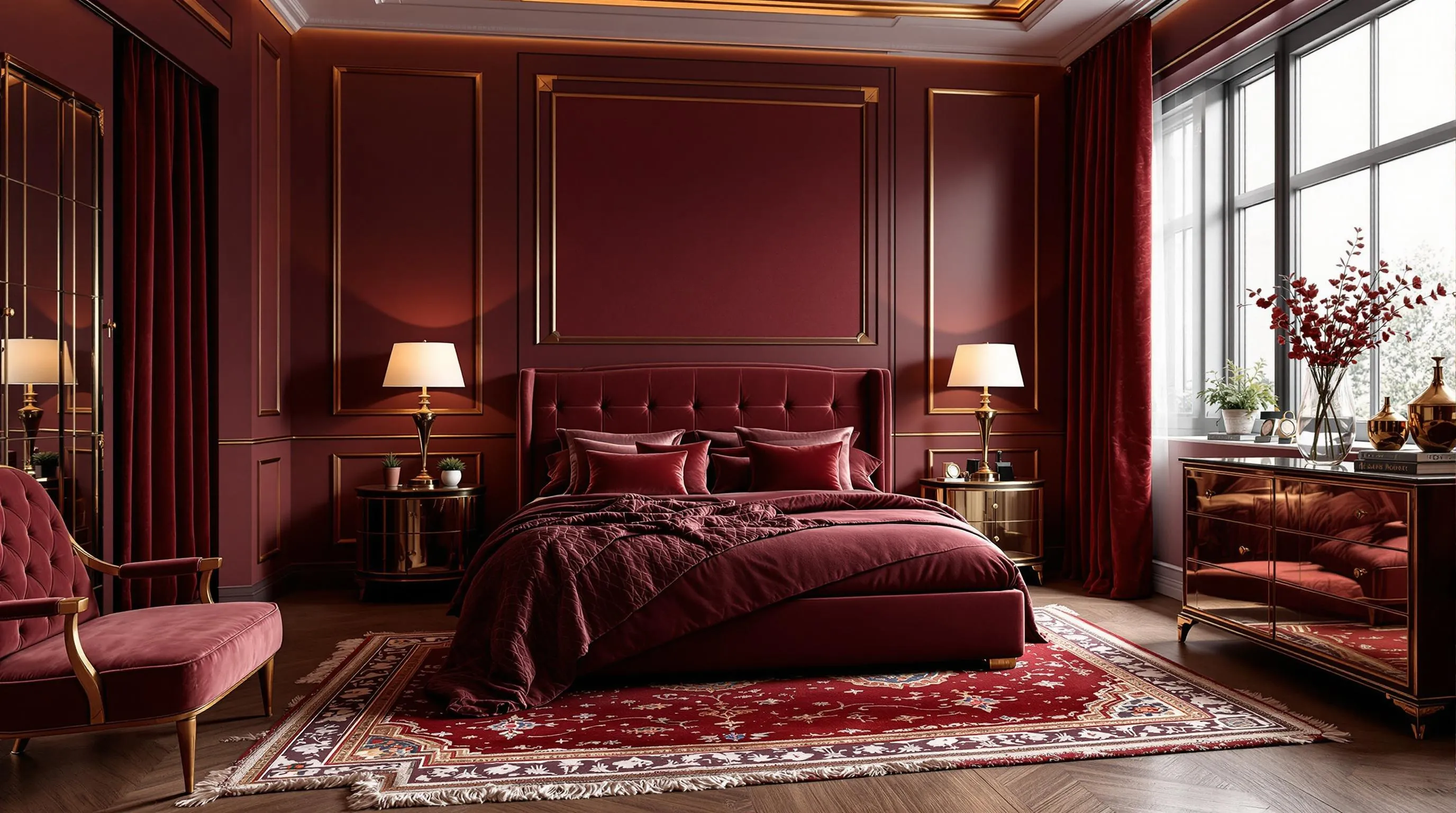
Burgundy and wine tones transform bedrooms into intimate, luxurious sanctuaries perfect for relaxation. These deep red hues add substantial warmth while maintaining sophisticated appeal, creating the ideal atmosphere for romantic retreats and peaceful escapes.
Burgundy Paired With Gold for Opulence
Burgundy walls or upholstery establish a dramatic foundation that pairs exceptionally well with gold accents throughout the bedroom. Gold-framed mirrors create stunning focal points that reflect light and enhance the room’s spaciousness. Elegant gold lamps cast a warm glow against rich burgundy backgrounds, highlighting the depth of this remarkable color. The metallic warmth of gold hardware on nightstands, dressers, and doorknobs introduces necessary contrast against the moody red tones. This classic combination elevates any bedroom’s opulence factor while balancing the inherent moodiness of burgundy with the brightness of gold touches.
Creating Warmth With Wine-Colored Textiles
Wine-colored bedding instantly transforms a neutral bedroom into a cozy haven through its light-absorbing properties that soften the room’s overall ambiance. Plush wine-colored curtains frame windows beautifully while contributing to the intimate atmosphere and improving insulation. Rich burgundy area rugs anchor the space with warmth underfoot, particularly when crafted from wool or bouclé for additional texture. Textural elements like velvet or faux fur in these deep red tones enhance both visual depth and tactile comfort, inviting touch and relaxation. Balance is key when working with these intense colors—incorporate neutral-toned furniture or lighter accent pieces to prevent the space from feeling overwhelmed by dark tones. The strategic layering of wine-colored textiles creates a sophisticated bedroom retreat that feels both luxurious and deeply comforting.
Mysterious Plum and Aubergine Hues for Artistic Bedrooms
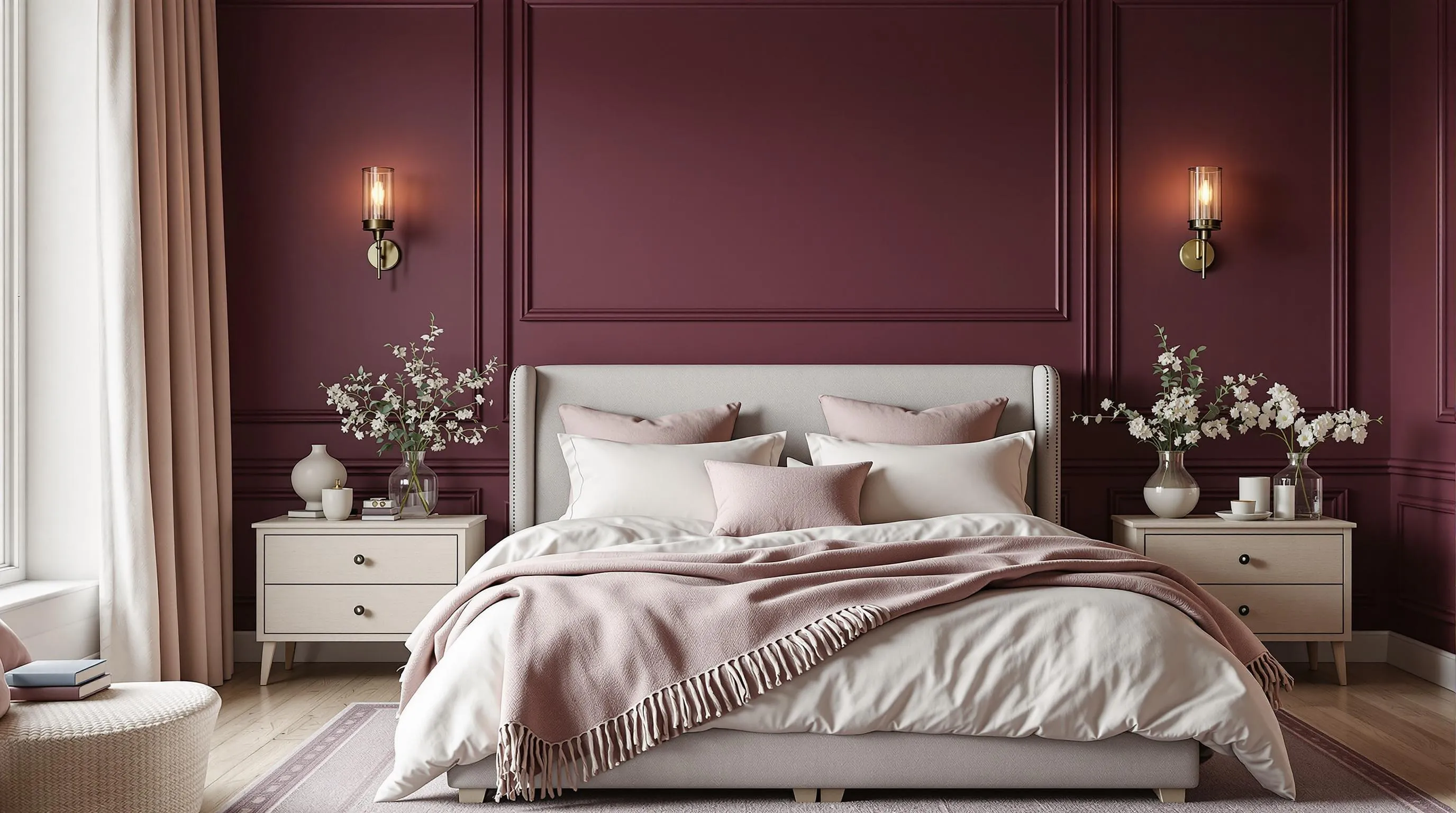
Plum and aubergine shades bring an undeniable sense of luxury and mystery to bedroom spaces, creating the perfect backdrop for artistic expression and deep relaxation. These rich, complex colors have become increasingly popular for those seeking to transform their bedrooms into sophisticated sanctuaries with a distinctive character.
Complementing Plum With Muted Pastels
Pairing plum with muted pastels creates a beautiful balance that softens the overall mood while maintaining the room’s cozy atmosphere. Soft lavender or blush accents through throw pillows, area rugs, or light fixtures can introduce gentle contrast against deeper plum walls or bedding. These pastel companions prevent the space from feeling overwhelming, instead fostering a harmonious blend of depth and lightness. Adding cream-colored linens or pale gray curtains further enhances this delicate balance, allowing the plum tones to remain the star while creating visual breathing room throughout the space.
Statement Walls in Aubergine
Creating a statement wall in bold aubergine instantly adds drama and visual interest to any bedroom. This approach works particularly well for those hesitant to commit entirely to dark colors but still wanting to incorporate their rich, emotional qualities. Painting just one wall in this deep purple-brown shade establishes a striking focal point behind the bed or opposite a window. Aubergine walls pair beautifully with neutral furnishings in cream, beige, or light wood tones, allowing the wall’s depth to stand out. Strategic lighting with wall sconces or bedside lamps helps showcase the wall’s rich complexity while ensuring the room maintains its cozy, intimate feel rather than appearing too dark or closed-in.
Chocolate Brown: The Underrated Cozy Bedroom Color

Chocolate brown creates an instantly cozy environment that few other colors can match. Farrow & Ball’s London Clay exemplifies how these warm brown tones add immediate comfort to bedroom spaces while creating a sophisticated, grounding atmosphere.
Earthy Brown Layers for Ultimate Comfort
Layering various shades of brown with creams or soft whites achieves the perfect balance of richness and contrast in bedroom design. Sherwin-Williams’ Web Gray, a near-neutral with brown undertones, pairs beautifully with white window frames to add dimension without overwhelming the space. Textured fabrics enhance the tactile comfort of brown-themed rooms, with options like faux fur throws, linen curtains, or velvet pillows adding visual interest and physical coziness. Brown’s natural versatility allows it to work seamlessly with wood elements and natural materials, creating a grounded, organic feel that promotes relaxation. Wall treatments with matte finishes reduce glare, further improving the cozy effect that makes dark brown such an effective choice for sleep spaces.
Brown With Cream for a Soft Contrast
Cream accents prevent brown-dominated bedrooms from feeling heavy or oppressive. White bed frames, Roman shades, or valances effectively break up dark walls, as demonstrated in designs featuring Behr’s Pastoral. Light-colored bedding introduces softness to the space, while metallic finishes in lighting fixtures or decorative objects add subtle glamour to the earthy palette. Warm, dimmable lighting maintains the calming mood that makes chocolate brown bedrooms so inviting. This careful balance of dark and light ensures a restful yet sophisticated atmosphere that promotes quality sleep. Browns absorb light effectively, fostering a serene environment that signals to the body it’s time to relax and unwind.
Designing With Black: Bold Tips for Bedroom Spaces
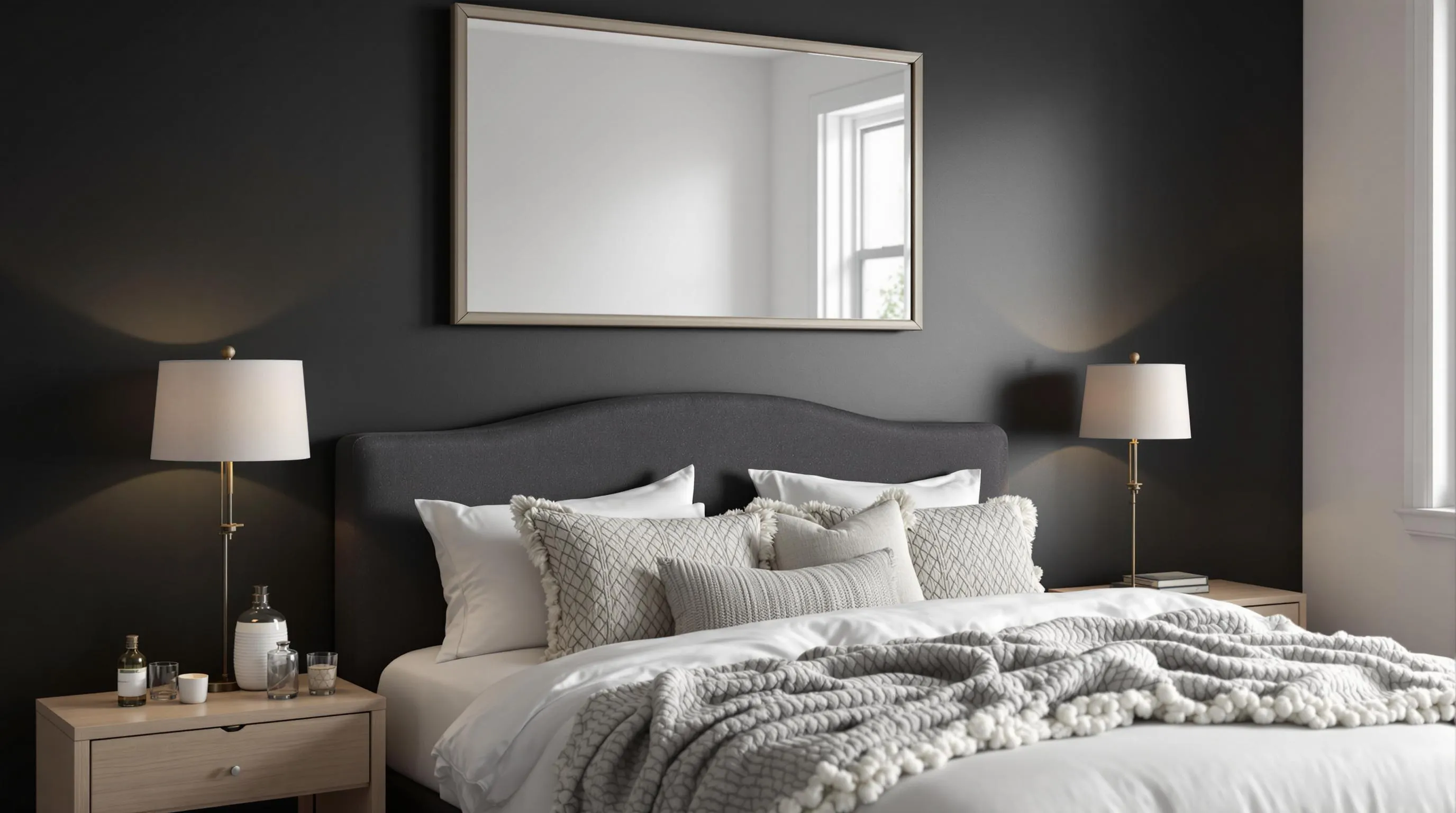
Black might seem intimidating for bedroom design, but when used strategically, it creates a sophisticated and deeply cozy atmosphere. We’ve compiled expert advice on incorporating this dramatic hue without overwhelming your sleep sanctuary.
Black Accent Walls That Don’t Overwhelm
Black accent walls can transform your bedroom when applied thoughtfully. Try painting just one wall black to create a striking focal point without dominating the entire space. This approach draws the eye while maintaining an open, breathable atmosphere throughout the rest of the room. Many designers recommend selecting the wall behind your headboard for this treatment, as it naturally frames the bed and creates visual interest where it matters most. Textured black finishes like matte or subtle patterns add dimension and prevent the wall from appearing flat or harsh. For even more visual interest, consider using black shiplap, wallpaper with subtle patterns, or a black paint with slight undertones that shift with changing light.
Balancing Black With Light Elements
Creating harmony with black requires thoughtful balance through lighter elements. Pair black walls or furniture with crisp white bedding to create contrast that keeps the space feeling fresh and airy. Incorporate natural materials like wooden nightstands or woven baskets to soften the starkness of black surfaces. Consider using black trim with a glossy finish to add sophistication and drama while reflecting light throughout the space. Large mirrors with light-colored frames help bounce natural light around the room, preventing dark elements from feeling oppressive. Textural elements in varying tones—like fluffy white throws, cream-colored pillows, and light rugs—create depth against black backgrounds while maintaining visual lightness. Strategic placement of lamps and soft lighting fixtures ensures the black elements reveal their rich depth rather than disappearing into shadows.
Lighting Techniques to Enhance Moody Dark Bedroom Colors
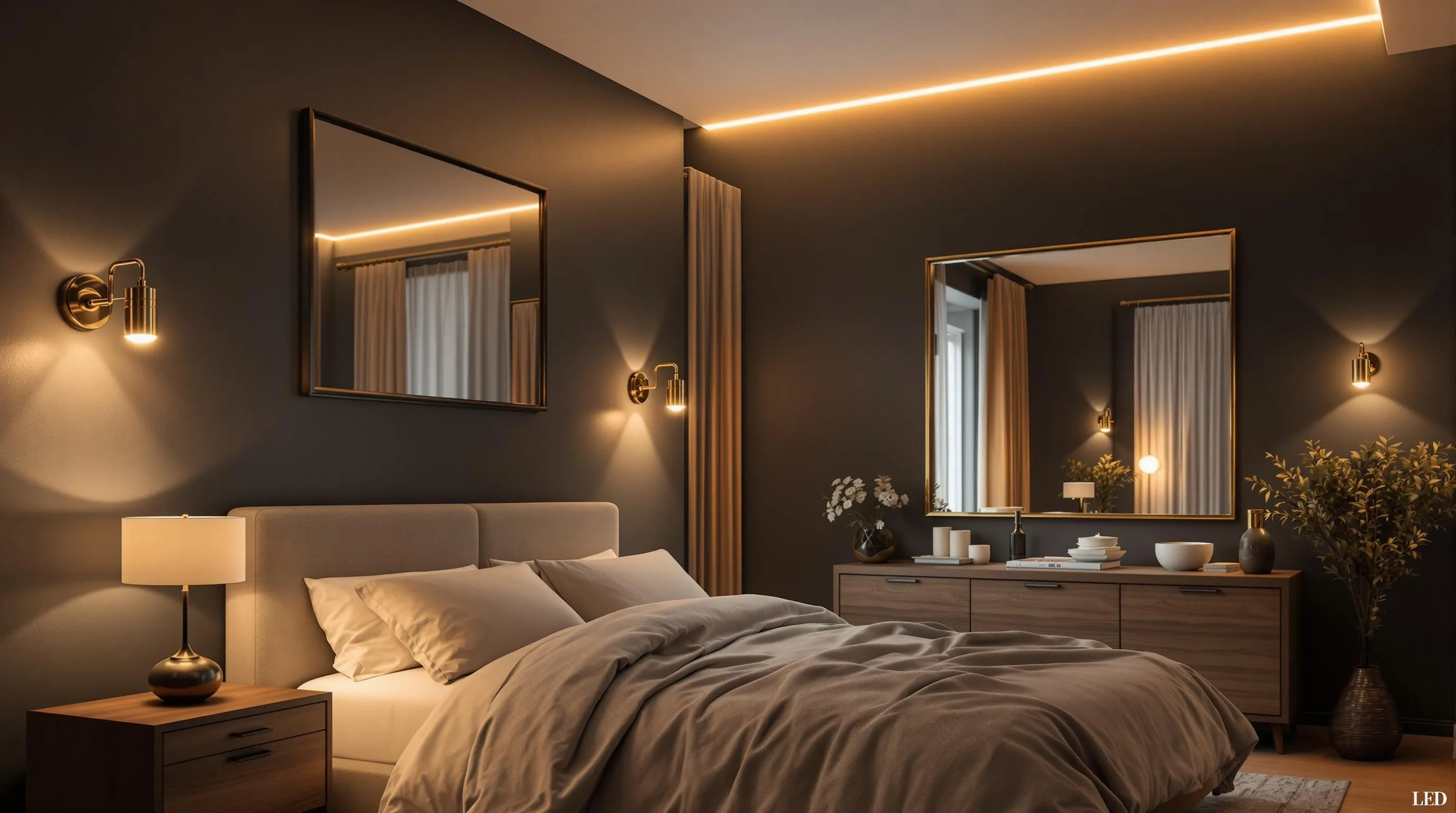
Warm Lighting Fixtures for Dark Spaces
Properly illuminating a dark-hued bedroom requires thoughtful lighting choices that complement rather than fight against the moody palette. Dimmable warm-toned bulbs (2700K-3000K) create ambient lighting that counteracts the potential heaviness of dark walls while maintaining their cozy appeal. We recommend implementing a layered lighting approach by combining wall sconces, table lamps, and floor lamps with brass or gold finishes to add warmth against deep-colored walls. For additional dimension, LED strip lights installed under beds or behind headboards provide soft, indirect illumination that enhances the room’s atmosphere without overwhelming the space. This strategic lighting placement creates pools of gentle light that highlight architectural features while preserving the intimate feel that makes dark bedrooms so inviting.
Natural Light Considerations for Dark Bedrooms
Balancing natural light with dark wall colors creates a ever-changing space that transitions beautifully from day to night. Lightweight, neutral-toned sheer curtains filter daylight effectively, maintaining the room’s cozy atmosphere while preventing it from feeling gloomy during daytime hours. Large mirrors positioned opposite windows serve a dual purpose—they amplify natural light during the day and reflect warm artificial lighting at night, making the space feel more expansive. To preserve a sense of openness in dark-walled rooms, pairing them with light-colored ceilings prevents that closed-in feeling that can sometimes occur with all-dark spaces. For bedrooms with dark green or blue walls, introducing wooden accents such as oak nightstands creates warmth and harmony with the cool tones. Rooms with off-black walls benefit from crisp white bedding or linen textures that soften the palette and add dimension, while low-sheen paint in satin or matte finishes reduces glare and creates a velvety backdrop that enhances your layered lighting strategy.
Bringing It All Together: Accessorizing Your Moody Bedroom
Embracing moody dark colors transforms your bedroom into the cozy sanctuary you’ve always dreamed of. These rich hues don’t just enhance sleep quality—they create a personal retreat that wraps you in comfort at day’s end.
Remember that accessories play a crucial role in completing your dark-hued haven. Plush throws metallic accents and thoughtfully layered lighting will elevate the entire experience. The contrast between your dark walls and carefully selected décor creates depth that simply can’t be achieved with lighter palettes.
We’ve shared our favorite moody colors from navy to chocolate brown each offering unique benefits for creating that perfect sleep environment. Now it’s your turn to experiment with these sophisticated shades and discover how they can transform your bedroom into the ultimate cozy retreat.
Frequently Asked Questions
Do dark colors really improve sleep quality?
Yes, dark colors can improve sleep quality by signaling the brain to unwind. Deep shades absorb light, reducing visual stimulation that interferes with rest. When combined with soft textiles and ambient lighting, colors like navy blue, charcoal, and plum help create a sleep-friendly environment by mimicking natural dimming at night, which supports healthy circadian rhythms.
Won’t dark walls make my bedroom feel smaller?
While conventional wisdom suggests dark colors shrink spaces, they actually create intimate sanctuaries by making rooms feel more contained and personal. Dark walls add depth and can make large bedrooms feel cozier. The key is balance—combine dark walls with proper lighting, mirrors, and lighter ceiling colors to maintain openness while enjoying the cocooning effect dark colors provide.
What’s the best dark color for a bedroom?
There isn’t one “best” dark color, but navy blue is exceptionally versatile. It creates a calming, intimate atmosphere while offering more warmth than black. Rich forest green connects to nature and promotes relaxation. Charcoal gray adds sophistication, while burgundy and wine tones create luxury. Choose based on your personal preference and the mood you want to create.
How do I prevent a dark bedroom from feeling too gloomy?
Balance is crucial. Incorporate lighter neutrals through bedding, rugs, or accent furniture. Add metallic elements like gold or brass fixtures to reflect light. Include proper layered lighting with warm-toned, dimmable options. Use mirrors strategically to bounce light, and consider keeping ceilings light-colored. Textural elements like velvet or faux fur will add warmth and dimension.
Can I use black in my bedroom without it feeling overwhelming?
Yes, black can create a sophisticated, cozy atmosphere when used strategically. Consider painting just one accent wall black (behind the headboard works well) rather than the entire room. Balance with crisp white bedding, natural materials, and textural elements. Proper lighting is essential—incorporate warm, ambient options that soften the space while highlighting black’s rich depth.
Which textiles work best with dark bedroom colors?
Richly textured fabrics enhance dark-colored bedrooms by adding depth and comfort. Velvet bedding, faux fur throws, and linen curtains create tactile interest against dark walls. Layer different textures for maximum effect—smooth silks with nubby wools, or crisp cottons with plush velvets. These combinations not only look luxurious but also improve sound absorption, contributing to a quieter sleep environment.
How should I approach lighting in a dark-colored bedroom?
Use a layered approach with warm-toned, dimmable lighting. Include ambient lighting (ceiling fixtures), task lighting (reading lamps), and accent lighting (wall sconces) to create depth. Position light sources at different heights to eliminate harsh shadows. Consider fixtures with brass or gold finishes to add warmth. For natural light, use sheer curtains that filter daylight without blocking it completely.
What accent colors pair well with moody dark bedrooms?
Metallics like gold, brass, and silver elevate dark colors and add glamour. For navy or charcoal, consider blush pink or mustard yellow accents. Forest green pairs beautifully with terracotta or cream. Burgundy works well with gold or sage green. For balance, incorporate some light neutrals regardless of your dark color choice. Natural wood tones add warmth and grounding to any dark palette.

